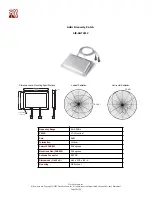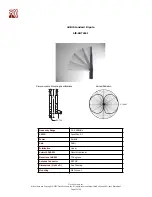
Cisco Systems, Inc.
All contents are Copyright © 2003 Cisco Systems, Inc. All rights reserved. Important Notices and Privacy Statement.
Page 8 of 29
Mounting Hardware
Each antenna requires some type of mounting. The standard dipole antenna simply connects to the RTNC connector on the back
of the unit. The 5.2 dBi mast mount omni and the yagi antennas are designed to mount to a mast up to 1.5 inches, and each comes
with mounting hardware for attachment. The 13.5 dBi yagi has an articulating mount option listed in the back of this document.
For most indoor applications, a .75" or 1" electrical conduit provides a suitable mounting. For outdoor application, a heavy
galvanized or aluminum wall mast should be used that will withstand the wind loading rating of the selected antenna. Patch
antennas are designed to mount flat against a wall or ceiling. Ceiling mount antennas are equipped with a drop ceiling cross member
attachment. The 21 dBi Parabolic Dish mounts to a 1.625" to a 2.375" mast. Fine threaded turnbuckles allow accurate aiming of
the antenna.
Lightning Arrestors
When using outdoor antenna installations, it is always possible that an antenna will suffer damage from potential charges
developing on the antenna and cable, or surges induced from nearby lightning strikes. The Aironet Lightning Arrestor is designed
to protect radio equipment from static electricity and lightning induced surges that travel on coaxial transmission lines. It protects
equipment from surges up to 5,000 Amperes. This will not prevent damage in the event of a direct lightning hit.
Theory of Operation
The Cisco Aironet Lightning Arrestor prevents energy surges from reaching the RF equipment by the shunting effect of the device.
Surges are limited to less than 50 volts, in about .0000001 seconds (100 nano seconds). A typical lightning surge is about .000002
(2 micro seconds).
Figure 5
Cisco Aironet Lightning Arrester
Lug
Lockwasher
Nut
Ground Wire
To Antenna
To RF Device








































